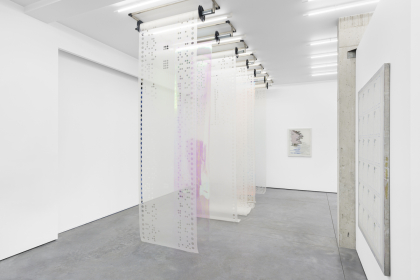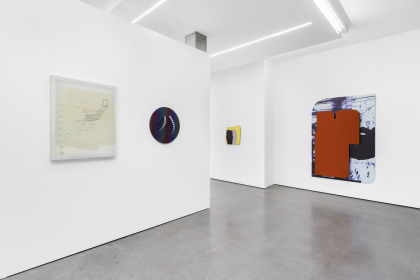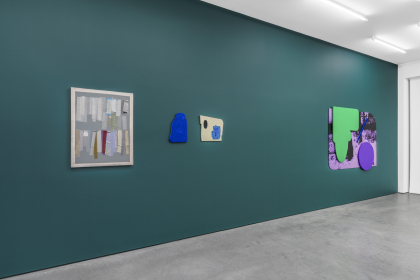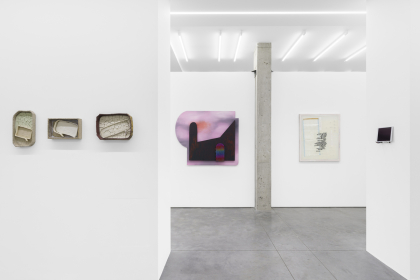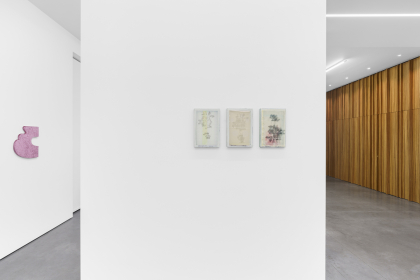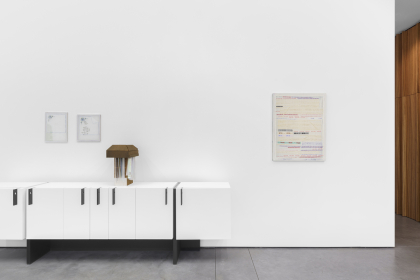
Zeros + Ones
Stéphanie Baechler
‘Cloths persist as records of the processes which fed into their production: how many women worked on them, the techniques they used, the skills they employed. The visible pattern is integral to the process which produced it; the program and the pattern are continuous.’
– Sadie Plant, Zeros + Ones (1997)
Sadie Plant writes that ‘holes are never simply absences’, a sentiment that Stéphanie Baechler takes as her mantra. In this exhibition Zeros + Ones—the title borrowed from Plant’s 1997 book of the same name—Baechler presents a collage of textile, photography, video, and printed works that insist wholly on presence. From addressing the holes of the traditional punch card to the holes in our collective cultural memory, the works in this exhibition present gaps as spaces that persist, totally alive with materiality, visibility, and remembrance.
In the summer of 2024, Baechler unveiled Forget Me Not, a large-scale public artwork installed at the architecturally monumental Tröckneturm in St. Gallen, CH. The Tröckneturm—or drying tower—was historically used to hang wet, dyed fabrics out to dry before being cut and sold. Lengths of heavy fabric would be hung from the top of the tower, dappling the dark wood of the structure with reams of freshly dyed red linen. Though we might typically think of designing or dyeing as key elements of textile production, the equally crucial drying stage is commonly overlooked. Similarly, these once-functional towers, now defunct, are also often overlooked, no longer beacons of industry but old diminishing posts dotting the Swiss horizon.
For the installation, the artist hung panels of hi-tech fabric from the tower in a bid to reanimate it, reminding us of the structure’s historic use, of the forgotten drying process, and of the human toil behind textile production. Baechler laser cut holes in these panels to render them giant punch cards, the pattern of which is a direct copy of the pattern used to embroider forget-me-not flowers onto traditional Swiss handkerchiefs. Named after this motif, the installation Forget Me Not beckons the forgotten structure and its history back into our line of sight.
Though the temporary installation was installed for a period of just three weeks, Baechler continues her trajectory of remembrance by bringing elements of this public work into Zeros + Ones.
Seven rolls of fabric leftover from the installation are punched with the forget-me-not design and displayed on motorised rollers inside the gallery. As a data carrier, the punch card is an early predecessor of the computer, its perforations a set of instructions. Where some may see illegible code or a strip of gaps, Baechler sees a tangible carrier of imagery, history, texture, and labour. Now positioned indoors and at eye level, attention is directed towards the tactility of the textile and the patterns of the holes themselves. Displayed nearby are the finished forget-me-not handkerchiefs, the proximity between this end result and the punched holes emphasising the unseen abstraction that turns data into image, gaps into stitches, absence into presence.
Other surplus materials leftover from the installation are stretched across second-hand silkscreen frames, which are displayed throughout the gallery like canvases. The glass fibre textiles used at the Tröckneturm are also displayed inside these frames, their materiality highlighted further by Baechler’s intervention; she has removed several strands from the grid-like fabric and woven ribbons embroidered with her poetry in their place. She applies fabric stiffener to these textiles, not only to replicate the stiffness of the punch card as a tool, but to freeze them in place, heightening their persistence. Even Baechler’s production process does not leave room for forgetting; she re-uses, reinvigorates, and re-presents.
In her wider research, Baechler takes great care to challenge our dematerialised moment, which might explain her insistence on presence. In search of what she terms a soulful mechanics, Baechler projects texture, shape, and weight onto the binary code of zeros and ones, employing this technology not as a time-saving device but as a motif of handiwork and history, of materiality and memory. At large, Baechler’s practice keeps a record of a material world in flux, and makes sensual and tangible offerings in response to an increasingly virtual world. In many ways, she offers us a moment of pause, asking us to look underneath, behind, and inside the seemingly seamless processes we are surrounded by. In doing so, the works presented in this exhibition serve to recall that which is forgotten, reveal that which is obscured, and retain that which, through contemporary processes of dematerialisation, is at risk of disappearing.
A series of clay sculptures sit amongst these hanging textiles. Imprinted using the perforations of punch cards, these pieces transmit the solid materiality of data through their textured surfaces where we might otherwise be left at a loss. The efficiency of modern machinery or the digital sleekness of algorithms give us little to hold on to.
Text by Harriet Foyster

